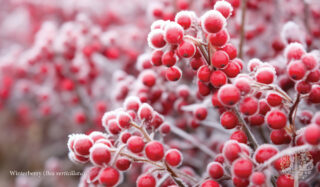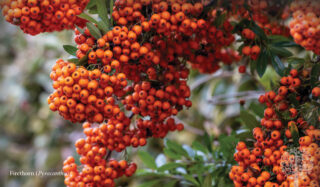Berry Bushes Offer Pops Of Color In Fall And Winter
Many ornamental shrubs and bushes start producing berries in the fall. During the rest of the year, these berry wonders are forgotten, with many, like the Beautyberry bush, growing flowers barely worth mentioning. But don’t count them out! Now is when they add interest to the barren gardenscape.

Beautyberry (Callicarpa bodinieri ‘Profusion’)
This beauty produces small pink flowers in the summer. Clusters of tiny amethyst-colored berries on long branches form in mid-September and last into December before the cold causes them to drop to the ground. A deciduous shrub that can grow 3 meters tall and wide, it’s easy to take care of. Hardy to climate zone 3 (-40°C), as long as it is watered and planted in full sun to light shade, it will do well in the ground or a large container.
Snowberry (Symphoricarpos albus)
Found growing wild throughout North America, the snowberry has earned a reputation as an ornamental border shrub. Hardy to zone 2 (-45°C), it’s tolerant of any soil type and grows in both shade and sun (although for maximum berry production, full sun is best). At a mature height of 2-3 meters tall and wide, it’s excellent in hedges or open naturalized garden areas. In mid-summer, it produces clusters of tiny pink flowers that turn into round, green berries, which eventually become white or pink during late fall.
Cotoneaster (C. lacteus)
Cotoneaster is considered invasive. Its red berries, however, make up for the plant’s sometimes over-enthusiastic habits. With so many varieties, cotoneaster is a berry must for the garden, especially these three. Bearberry cotoneaster is hardy to zone 4 (- 25°C), enjoys full sun, and has a cascading habit perfect for slopes or garden walls. C. Divaricatus, or spreading cotoneaster, is deciduous with dark green leaves that turn orange or red in fall, giving way to bright red berries loved by birds. It grows to 3 meters tall and wide, is hardy to zone 2, and thrives in full sun to part shade. C. Horizontalis, or rockspray cotoneaster, is also hardy to zone 2 and deciduous with clusters of red fruits. Growing 1-3 meters tall and up to 9 meters wide, it, like most cotoneaster, does not enjoy being planted in a container but will flourish if left to grow as a hedge or ornamental shrub in the back of the garden.

Winterberry (Ilex verticillata)
Related to the holly shrub, winterberry is native to the northeastern United States and grows in marshy areas. Deciduous and needing both male and female plants to produce berries, the plant’s tiny white flowers appear in summer and turn into bright red berries that stay on the branches for most of the winter. In zone 3, it will grow from 2 to 4 meters in sun or part shade in most soil types.
Firethorn (Pyracantha)
Pyracantha is a semi-evergreen in cold climates or evergreen shrub in warmer ones. A perfect espalier for fences or along a garden wall, it’s a rampart grower that can quickly exceed 4 meters tall and 3 meters wide. A sun lover who does not like being confined by a container, it’s hardy to zone 3 and produces bright red or orange berries in late fall. Its sharp thorns make it a deer-resistant plant that will act as a natural barrier when planted around the garden’s perimeter.





